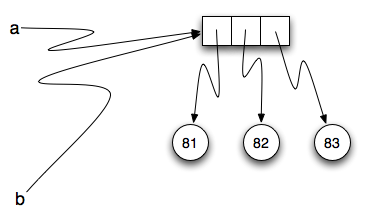Aliasing¶
Since variables refer to objects, if we assign one variable to another, both variables refer to the same object:
In this case, the reference diagram looks like this:

Because the same list has two different names, a and b, we say that it
is aliased. Changes made with one alias affect the other. In the codelens example below, you can see that a and b refer
to the same list after executing the assignment statement b = a.
(chp09_is3)
Although this behavior can be useful, it is sometimes unexpected or undesirable. In general, it is safer to avoid aliasing when you are working with mutable objects. Of course, for immutable objects, there’s no problem. That’s why Python is free to alias strings and integers when it sees an opportunity to economize.
Check your understanding
- [4, 2, 8, 6, 5]
- blist is not a copy of alist, it is a reference to the list alist refers to.
- [4, 2, 8, 999, 5]
- Yes, since alist and blist both reference the same list, changes to one also change the other.
list-11-1: What is printed by the following statements?
alist = [4, 2, 8, 6, 5]
blist = alist
blist[3] = 999
print(alist)